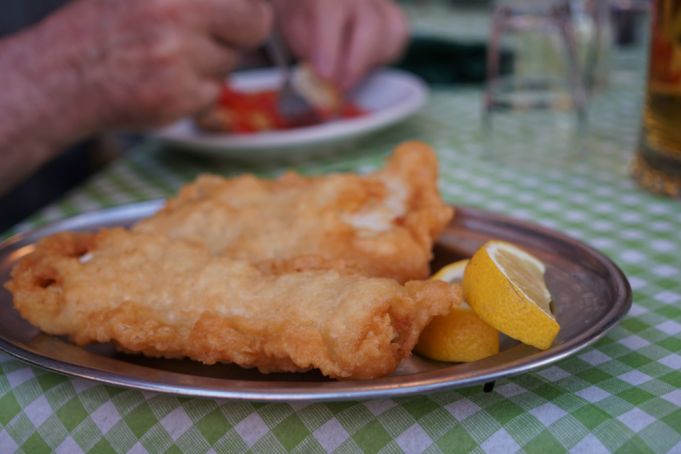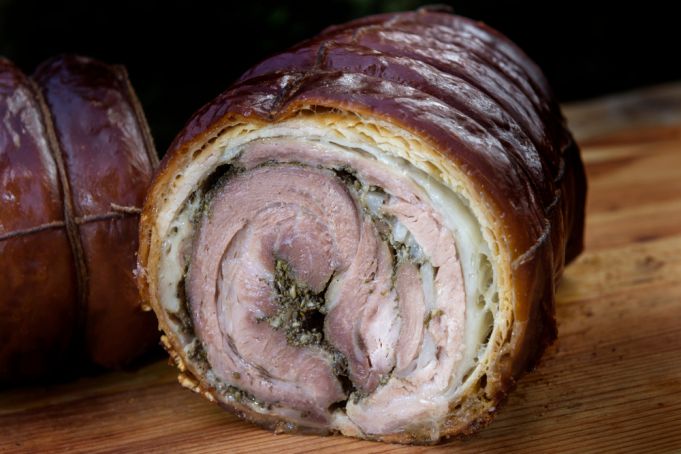An Italian menu guide with extra helpings of etymology.
First up is ‘a’ for abbacchio. These days it means meat of a young lamb, an Easter and Christmas favourite; less appetisingly the word comes from the shepherd’s crook – ad baculum – used to lead the creature to slaughter.
Baccalà (traceable to a Nordic word bakkeljauw / salted cod) is a common element in Roman cuisine, sometimes mantecato / buttered. The cod delicacy, however, originates from Venice and beyond. Its story, mixing courage with entrepreneurship, would not be out of place in a Norse saga.
In the winter of 1432 Venetian captain, Pietro Querini, was shipwrecked off the French coast, his lifeboat then drifting as far as Rost, an island off Norway. His Nordic rescuers hosted him for three months, time enough for Querini to observe a new way of curing fish.
Following his return to his Venice, he set up an import business of the same product. In an age when meat was often in short supply, Querini’s fish became a popular substitute.
Served in paper cones, the fish, duly desalted and fried, is now a speciality of Rome’s Jewish Ghetto area. Rather ungratefully to the fish, perhaps from the ease with which cod were once caught, “fare la figura di baccalà” connotes stupidity. Or sometimes thinness, as does its counterpart stoccafisso, also cod but dried on sticks rather than salted. As in the old Dutch word stokvisch, referring to the racks upon which the fish were laid out or the fishes' resulting stick-like hardness, the etymology having it both ways.

B is also for bruschetta from the Romanesco adjective ‘brusco’, in standard Italian ‘abbrustolito’/ toasted. A form of bread, “once for the poor, now a delicacy for the most sophisticated” to cite Giuliano Malizia’s Piccolo Dizionario Romanesco.
And so to pasta. Regarding both etymology and how best to attain the necessary creaminess, one of the most polemical of foods is the calorifically supercharged alla carbonara. The name has been traced to Abruzzo woodsmen who would take with them into the hills a dish of pasta mixed with eggs and cheese. The carbonara refers to charcoal, the end product of the woodsmen’s work. The mountain staple, some people claim, only reached Rome in 1944 when American soldiers would add bacon to align it with their breakfast back home.
A change in ingredients then, though the name stuck. Romans reappropriated the dish by substituting bacon/pancetta with the more locally authentic guanciale / smoked pig’s cheek, an ingredient most diners and chefs would agree makes all the difference. Yes, as used in pasta all’amatriciana, from Amatrice, a small town in Lazio’s north-east corner, whose pig-farms line the approach roads.
Lacking the rich tomato-based sauce of l'amatriciana, there is a prototype in simpler “white” version: spaghetti alla gricia – from, in one entry, Grisciano, a tiny village near Rieti. Others cite a similarly-named family of Swiss grocers. No matter. The dish, well-cooked, serves to minimise any lexical disputes.
The English-speaking world, to our loss, tends to make spaghetti and pasta synonymous. Yet Il Grande Dizionario Garzanti has a page illustrating the different varieties distinguishable by length (pasta lunga or corta), thickness and above all shape: butterflies/ farfalle, worms / vermicelli, snails / lumache; thimbles / ditali, pipes / pipe, tubes/ cannelloni; then helices / eliche, spirals / fusilli, stars / stellini (in a sky of soup); little ears / orecchiette.
All self-evident, unlike tonnarelli: Nothing to do with tuna but from tondo /round although the shape is square, if one get one’s stomach round that. Then ravioli, etymologies referring to a Genovese cook of the same name, to rabiola, to our good old northern turnip or to groviglio / in modern Italian a tangle but in another meaning a type of stuffing.
Similarly elusive are strozzapreti / “priest-choker”. Dictionaries define it as “pasta” or “a form of gnocchi” according to region: gnocchi near Trento and in Alto Adige, where it is also known as strangolapreti, and pasta in central Italy and elsewhere.
Naples pins the term, in its Neapolitan incarnation strangulaprievete, on a certain abbot, Galiani (1728-1787), who in his enthusiasm for the dish risked self-strangulation. On a similarly anti-clerical note, the northern Emilia-Romagna region has a story that the name reflects a wish, on the part of impoverished parishioners, that voracious prelates would meet a similar fate as the one in Naples.
A footnote points out how the custom of church landlords was to partially settle their ground-rents in the form of food; this “poor” dish was offered as a particularly effective way of doing it. A more neutral etymology is the similarity of the pasta’s shape to a cleric’s collar. Or maybe the origin is phonetical: from Greek’s strongulos e preptos, meaning round-shaped.
From pasta to pizza. Alberto Angelo in Gusti traces this quintessentially Italian delight to ancient Egypt, at least in its shape and base. Then, etymologically, to Byzantine Greek: pitta, the bread nowadays spelt with a single t. Or to Longobard bizzo / a bite. Whatever, the first recorded use of “pizza” was as early as 997 when the Bishop of Gaeta, north of Naples, stipulates that one of his tenants send him duodecim pizze /12 pizzas each Easter and Christmas. A pity the same cleric was not around centuries later to preside over pizza’s marriage with the tomato. Or at least its passata /paste/ id est passed through a sieve to remove seeds and skin.
Tomatoes still whole on their plant were initially prized for decoration rather than for eating. Add white mozzarella cheese and fresh green basil and in Pizza Margherita you are served up the colours of the Italian flag honouring the eponymous queen. Pizza Bismark, for its part, was named to celebrate the 1882 Italian-Austrian-German alliance.
Whether the fried egg in the middle represents the Prussian emperor’s helmet is up to the consumer. Not to be outdone by Naples, pinsa and pinserie are Rome’s equivalents. Both, fittingly enough, from the Latin pinsere: to work dough into comparatively thick strips.

And so to porchetta. In England meat and the animal which it is cut often have different names. The origin of this goes back to the Norman Conquest: Old English words for the cattle raised in the fields by the hapless Anglo-Saxon peasant, Norman French/Latinised equivalents for the meat once it arrived at the (Norman) Lord of the Manor’s table.
For example, sheep-mutton, swine / pork, cow / beef, etc. Here, though, the animal arrives before the diner both verbally and, except for the absence of bones, physically intact. Adjacent from Rome’s opera house is a restaurant a little larger than a cubbyhole. Three-wheelered in from the Colli Romani, the animal here sports a pair of sunglasses to attract customers. With a quarto of white wine, one can sample slices of the same spiced meat to order.
Elsewhere, in Rome's Piazzale Prenestina, a kiosk sells at €3 each porchetta sandwiches, a super-snack to be consumed while waiting for the bus? Back in Ariccia, its place of origin, the animal/meat has its annual festival, and likewise in Piglio near Frosinone.
Similarly-sounding scarpetta, as in “fare la scarpetta”, is not a shoe, but bread shaped into one to scoop up any left-overs from your plate. “The last mouthful and the most exquisite,” enthuses Giuliano Malizia’s Piccolo Dizionario Romanesco.

Finally dessert. From Treviso near Venice comes tiramisù / pick me up. Fittingly for a dish from Casanova’s hometown, it was once touted as an aphrodisiac. (cf. and more respectably, the ad for coffee, a key ingredient, ‘Give your life a little lift.’)
Or you might try a zabaione or zaglione, a sort of custard / trifle with Marsala wine. The name has been twinned with a mediaeval mercenary, Giovan Paolo Baglioni, or, more peaceably, with Franciscan monk Pasquale Baylon, patron saint of pastry cooks. Other theories link it with the Illyrian word for barley beer or the Emilian one for food (zibanda).
With so many etymologies, small wonder that in the broader sense the word connotes a random but happy mixture. Another incarnation of the word, at least according to some, is Zibaldone, as in the title of the notebooks by the famously sweet-toothed Leopardi, a sort philosophical, literary and sometimes gastronomical ‘trifle’ where, over a period of 15 years, the poet jotted down his musings.
So, suggesting an agnostic’s “bread of heaven”, he writes on page 4184, “Eating, that most interesting of occupations, needs to be done well since on good digestion depends a man’s well-being, his good physical state and thus his mental and moral health as well.”
By Martin Bennett
This article was published in the June 2022 online edition of Wanted in Rome magazine.


















